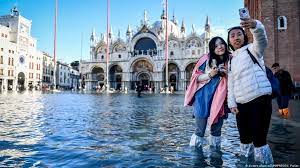Italy: Could Venice lose its heritage status?

Venice: The United Nations Educational, Scientific and Cultural Organization (UNESCO) on Monday warned that the city faced ‘irreversible’ damage.
The recommendation will now go to a meeting of UNESCO’s World Heritage Committee in Riyadh in September for adoption.
This could result in Venice being placed on the World Heritage in Danger list.
But what happened exactly? What is the heritage status? What do we know about the ‘black list’?
UNESCO in its recommendation stated Venice risked “irreversible” damage due to a string of issues ranging from climate change to mass tourism.

“The effects of the continuing deterioration due to human intervention, including continuing development, the impacts of climate change and mass tourism threaten to cause irreversible changes to the outstanding universal value of the property,” said UNESCO.
“Some of these long-standing issues have already led to the deterioration of the inherent characteristics of the property and its attributes,” UNESCO said, warning that developments including high rise buildings risk “having significant negative visual impact”.
“Moreover, the combined effects of human induced and natural changes are causing deterioration and damage to build structures and urban areas,” it added.
It said that overall, there was a “lack of significant progress” by Italy in addressing these issues and this was further “hindered by a lack of overall joint strategic vision”.
The World Heritage status is a coveted and treasured label given to sites around the world.
According to The New York Times, the tag is given to landmarks that have historical, scientific or cultural significance.
There are 1,157 such sites across the world including Machu Picchu, the historic center of Florence and the Taj Mahal.
The status, which denotes a site’s outstanding universal value to humanity, is awarded by the World Heritage Committee.
Intense lobbying is often employed by delegations to ensure their national cites are given — and retain — the status.
“Once a site is inscribed, it is first the responsibility of the government of the country where the site is located to put in place all measures to protect the site,” Lazare Eloundou Assomo, the director of the UNESCO World Heritage Center, told The New York Times.
The former city-state of Venice was inscribed on the Heritage list in 1987 as “an extraordinary architectural masterpiece in which even the smallest building contains works by some of the world’s greatest artists.”
The committee, which is set to meet in Riyadh from 10 to 25 September, will examine 53 new candidate sites for addition to the World Heritage List.
Placing a city or site on the “in danger” list is meant to alert authorities to the need to do a better preservation job or draw the attention of the world to a looming problem.
As the UNESCO website explains, “The List of World Heritage in Danger is designed to inform the international community of conditions which threaten the very characteristics for which a property was inscribed on the World Heritage List, and to encourage corrective action.”
The UNESCO lists armed conflicts, war, earthquakes, natural disasters, unchecked tourism, pollution, poaching and uncontrolled urbanisation as threats to World Heritage sites.
“Dangers can be ‘ascertained’, referring to specific and proven imminent threats, or ‘potential’, when a property is faced with threats which could have negative effects on its World Heritage values,” the website states.
In plain English, this means a site or city can be stripped of its World Heritage label if the authorities take steps deemed unsatisfactory by the committee.
A site can also be removed from the World Heritage in Danger List and the World Heritage list – which the UNESCO has only done twice in history.
While the website states that putting a city on the list is not meant to be viewed as a sanction, some say such a move is viewed as a rebuke of the local management of World Heritage sites.
The committee comprising 21 UNESCO member states will in September also review more than 200 sites and decide which to add to its danger list.
For nearly 10 of these sites, the experts recommend that member states put them on the danger list, among which already are the historic centre of Odessa, Ukraine, the town of Timbuktu in Mali, and several sites in Syria, Iraq and Libya.
Other sites recommended to be put on the danger list this year are the cities of Kyiv and Lviv in Ukraine.
The UNESCO has been concerned about Venice for years.
Venice, known for its canals and cultural sites, has in recent times been struggling with mass tourism.
On a single day during the 2019 Carnival, some 193,000 people squeezed into the historic centre. Venice has been preparing to introduce a fee for day-trippers to control visitor numbers, but has been delayed by objections.
As per Euro News website, 25 million people visited Venice in 2019 – a record.
Meanwhile, the city of just over 50,000 residents continues to lose around 1,000 per year.
A draft resolution prepared for adoption by the World Heritage Committee said there had not been “a significant level of progress in addressing the persistent and complex issues” and added measures proposed by Italy were “still insufficient and need to be further developed”.
Venice has battling mass tourism for years. AP
It added that Italy “has not been communicating in a sustained and substantive manner since its last Committee session in 2021 when UNESCO had already threatened to blacklist Venice.
Back then, the city narrowly avoided being named a world heritage site in danger – just weeks after Italy moved to ban large cruise ships from sailing into the city center.
As per Euro News website, the move was thought to have impacted the UNESCO’s decision not to put Venice on the danger list.
Venice was previously in danger of being put on the ‘black list’ in 2019, 2017 and 2015.
UNESCO said it hoped inscription on the danger list “will result in greater dedication and mobilisation of local, national and international stakeholders.”
In the city itself as the recommendation was announced, there was agreement that the current state of the city was letting everyone down.
“It’s uncontrollable” said gondolier Antonio Vertotto, of the masses of tourists who visit the city each day, adding that the government had done “nothing” for years to control it.
“I would say there are too many tourists, but the solution, that’s hard to say,” said tourist Valmir Reznik, 34, visiting for the day from Switzerland with his wife. “We thought it’s Monday, maybe it’s not so full, but we were wrong.”
A spokesperson for the Venice municipality told Reuters the city “will carefully read the proposed decision published today by the Center for UNESCO’s World Heritage Committee and will discuss it with the government”.
Ex-Venice mayor Massimo Cacciari told BBC that UNESCO is “one of the most expensive and useless bodies on the face of the earth” that passes “judgement without knowledge” and “give opinions left and right, which we would do best to disregard”.
“They don’t give us any funding to make changes, all they do is criticise… As if Venice needed UNESCO to be a world heritage site! We need more action and fewer words.”
In a related recommendation announced Monday, UNESCO said its experts believed Australia needed more time to boost protection of the Great Barrier Reef before it was declared “in danger” due to the risk of damage from climate change.





